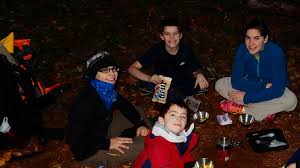backpacking merit badge pamphlet

Discuss the prevention of and treatment for the health concerns that could occur while backpacking, including hypothermia, heat reactions, frostbite, dehydration, insect stings, tick bites, snakebite, and blisters. a. List 10 items that are essential to be carried on any backpacking trek and explain why each item is necessary. b. Describe 10 ways you can limit the weight and bulk to be carried in your pack without jeopardizing your health or safety. a. Define limits on the number of backpackers appropriate for a trek crew. b. Describe how a trek crew should be organized. c. Tell how you would minimize risk on a backpacking trek. d. Explain the purpose of an emergency response plan. a. Describe the importance of using Leave No Trace principles while backpacking, and at least five ways you can lessen the crew’s impact on the environment. b. Describe proper methods of handling human and other wastes while on a backpacking trek. Describe the importance of and means to assure personal cleanliness while on a backpacking trek.

c. Tell what factors are important in choosing a campsite. a. Demonstrate two ways to treat water and tell why water treatment is essential. b. Explain to your counselor the importance of staying well hydrated during a trek.
flapover drawstring laptop backpack victorinox a. Demonstrate that you can read topographic maps.
nanamica roll-top cycling backpack b. While on a trek, use a map and compass to establish your position on the ground at three different locations, OR use a GPS receiver to establish your position on a topographic map and on the ground at three different locations.
dakine rhapsody backpack c. Explain how to stay found, and what to do if you get lost.
backpack af100
Tell how to prepare properly for and deal with inclement weather. a. Explain the advantages and disadvantages of the different types of backpacking stoves using at least three different types of fuel. b. Demonstrate that you know how to operate a backpacking stove safely and to handle liquid fuel safely. c. Prepare at least three meals using a stove and fuel you can carry in a backpack. d. Demonstrate that you know how to keep cooking and eating gear clean and sanitary and that you practice proper methods for food storage while on a backpacking trek. a. Write a plan that includes a schedule for a patrol/crew backpacking hike of at least 2 miles. b. Conduct a prehike inspection of the patrol and its equipment. c. Show that you know how to properly pack your personal gear and your share of the crew’s gear and food. d. Show you can properly shoulder your pack and adjust it for proper wear. e. While using the plan you developed for requirement 9a, carry your fully loaded pack to complete a hike of at least 2 miles.

Using Leave No Trace principles, participate in at least three backpacking treks of at least three days each and at least 15 miles each, and using at least two different campsites on each trek. Carry everything you will need throughout the trek. a. Write a plan for a backpacking trek of at least five days using at least three different campsites and covering at least 30 miles. Your plan must include a description of and route to the trek area, a schedule (including a daily schedule), a list of food and equipment needs, a safety and emergency plan, and a budget. b. Using Leave No Trace principles, take the trek planned and, while on the trek, complete at least one service project approved by your merit badge counselor. c. Keep a daily journal during the trek that includes a day-by-day description of you activities, including notes about what worked well and thoughts about improvements that could be made for the next trek. The official source for the information shown in this article or section is:Boy Scout Requirements, 2016 Edition (BSA Supply SKU #621535)

Please note any errors found in the above requirements on this article's Talk Page. Explain to your counselor the most likely hazards you may encounter while hiking, and what you should do to anticipate, help prevent, mitigate, and respond to these hazards. Show that you know first aid for injuries or illnesses that could occur while hiking, including hypothermia, frostbite, dehydration, heat exhaustion, heatstroke, sunburn, hyperventilation, altitude sickness, sprained ankle, blisters, insect stings, tick bites, and snakebite. Explain and, where possible, show the points of good hiking practices including proper outdoor ethics, hiking safety in the daytime and at night, courtesy to others, choice of footwear, and proper care of feet and footwear. Explain how hiking is an aerobic activity. Develop a plan for conditioning yourself for 10-mile hikes, and describe how you will increase your fitness for longer hikes. Take the five following hikes, each on a different day, and each of continuous miles.

These hikes MUST be taken in the following order: You may stop for as many short rest periods as needed, as well as one meal, during each hike, but not for an extended period (example: overnight). Prepare a written hike plan before each hike and share it with your Scoutmaster or a designee. Include map routes, a clothing and equipment list, and a list of items for a trail lunch. Take a hike of 20 continuous miles in one day following a hike plan you have prepared. You may stop for as many short rest periods as needed, as well as one meal, but not for an extended period (example: overnight). After each of the hikes (or during each hike if on one continuous "trek") in requirements 4 and 5, write a short reflection of your experience. Give dates and descriptions of routes covered, the weather, and any interesting things you saw. It may include something you learned about yourself, about the outdoors, or about others you were hiking with. Share this with your merit badge counselor.